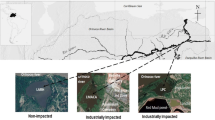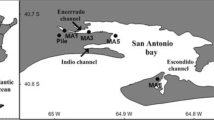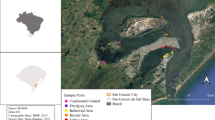Abstract
Background, aim, and scope
Bahía Blanca estuary is characterized by the occurrence of large intertidal areas, including both naked tidal flats and salt marshes densely vegetated with Spartina alterniflora. The estuary is strongly affected by human activities, including industrial and municipal discharges, harbor maintenance, cargo vessels and boat navigation, oil storage and processing, etc. Even numerous studies have reported the occurrence and distribution of heavy metals in sediments and biota from this estuary, although the function of the halophyte vegetation on metals distribution was at present not studied. The main objective of the present study was to understand the potential role of the salt marshes as a sink or source of metals to the estuary, considering both the obtained data on metal levels within sediments and plants from the studied areas at naked tidal as well as vegetated flats.
Materials and methods
The selected study area, named Villa del Mar, was located in the middle estuary coast. The sampling was carried out under low tide conditions, and the sampling area was divided into two parts: A (close to Villa del Mar) and B (north-westerly of Villa del Mar). In each part, two integrated samples of S. alterniflora (the first in the medium-salt marsh and the second in the higher one) were collected. Also sediments associated with the roots of S. alterniflora were taken at the same locations, in addition to another sediment sample from the naked zones of the tidal flats (without any vegetation). After corresponding treatment at the laboratory, plant and sediment samples were mineralized according to Marcovecchio and Ferrer, J Coast Res 21:826–834, 2005), in order to measure their metal concentrations by atomic absorption spectroscopy (AAS). Analytical quality (AQ) was checked against certified reference materials from NIES, Tsukuba (Japan).
Results
Most of the Spartina samples have shown highest Cd and Mn concentrations in the aerated parts of the plants, indicating an allocation process from the roots up to the leaves. Most of the samples have presented non-detectable Pb and Cr values. Cu, Fe, Ni, and Zn have presented highest concentrations in the underground parts of the plant, suggesting an accumulation process in the roots and rhizomes. In the case of sediments, samples from those sites located far away from Villa del Mar have presented greater concentrations on the sediments associated with underground parts of Spartina than those from the naked tidal flat, for almost all of the metals studied. Unlike this, the samples from the site close to Villa del Mar have shown the higher concentrations in sediments from the naked tidal flat.
Discussion
Marsh plants are known to absorb and accumulate metals from contaminated sediment, and this is one reason that allows wetlands to be used for wastewater treatment. It was observed that those sets of samples from the same salt marsh levels (e.g., A.1 and B.1, or A.3 and B.3) have shown similar heavy metal distribution trends, although even their corresponding concentrations could be different. Thus, the concentrations of Cu, Zn, Ni, and Fe in the medium-salt marshes were higher in the underground tissues (roots plus rhizomes), with the exception of Mn, which was seen to be higher in the aboveground parts. The same tendency occurs at high-salt marshes for these heavy metals, with the exception of Ni. This fact was sustained regarding the fact that the levels mentioned (medium-salt marsh and high-salt marshes) must have the same exposition to heavy metal sources, similar physical-chemical conditions regulating metal distribution within the compartments on the salt marshes or, simultaneously, both mentioned processes. Moreover, metals in this macrophyte can remain after the leaves have died and turned into detritus. The metals present in the detritus can be passed on to consumers (Quan et al., Mar Environ Res 64:21–37, 2007)). Kee** in mind that Bahía Blanca estuary’s salt marshes are inundated twice each day by tidal water for 3–4 h, macrophytes may act as a conduit for the movement of metals from the sediment to the estuarine body and near-coastal system.
Conclusions and recommendations
Considering the comments on the previous paragraphs, salt marshes from Bahía Blanca estuary are sources or sinks for metals? It can be sustained that both are the case, even if it is often stated that wetlands serve as sinks for pollutants, reducing contamination of surrounding ecosystems (Weis and Weis, Environ Int 30:685–700, 2004)). In the present study case, the sediments (which tend to be anoxic and reduced) act as sinks, while the salt marshes can become a source of metal contaminants. This is very important for this system because the macrophytes have been shown to retain the majority of metals in the underground tissues, and particularly in their associated sediments. This fact agreed well with previous reports, such as that from Leendertse et al., Environ Pollut 94:19–29, 1996) who found that about 50% of the absorbed metals were retained in salt marshes and 50% was exported. Thus, kee** in mind the large spreading of S. alterniflora salt marshes within Bahía Blanca estuary, it must be carefully considered as a re-distributor of metals within the system.

Similar content being viewed by others
References
Almeida CMR, Mucha AP, Vasconcelos MTSD (2004) Influence of the sea rush Juncus maritimus on metal concentration and speciation in estuarine sediment colonized by the plant. Environ Sci Technol 38:3112–3118
Botté SE (2005) El rol de la vegetación en el ciclo biogeoquímico de metales pesados, en humedales del estuario de Bahía Blanca. Tesis Doctoral. Universidad Nacional del Sur (UNS), Bahía Blanca, Argentina, 290 pp
Burke DJ, Weis JS, Weis P (2000) Release of metals by the leaves of the salt-marsh grasses Spartina alterniflora and Phragmites australis. Estuar Coast Shelf Sci 51:153–159
Cacador I, Vale C, Catarino F (2000) Seasonal variation of Zn, Pb, Cu and Cd concentrations in the rootsediment system of Spartina maritime and Halimione portulacoides from Tagus estuary salt-marshes. Mar Environ Res 49:279–290
De Marco SD, Botté SE, Marcovecchio JE (2006) Mercury distribution in abiotic and biological compartments within several estuarine systems from Argentina: 1980–2005 period. Chemosphere 65:213–233
Dorgelo J, Meester H, Vanvelzen C (1995) Effects of diet and heavy metals on growth rate and fertility in the deposit feeding snail Potamopyrgus jenkinsi. Hydrobiologia 315:199–210
Duarte B, Delgado M, Caçador I (2007) The role of citric acid in cadmium and nickel uptake and translocation, in Halimione portulacoides. Chemosphere 69:836–840
Ferrer L, Contardi E, Andrade S, Asteasuain R, Pucci A, Marcovecchio J (2000) Environmental cadmium and lead concentrations in the Bahía Blanca Estuary (Argentina). Potential toxic effects of Cd and Pb on crab larvae. Oceanologia 42:493–504
Ferrer L, Andrade S, Asteasuain R, Marcovecchio J (2006) Acute toxicity of four metals to early life-history stages of the crab Chasmagnathus granulata from Bahía Blanca Estuary, Argentina. Ecotoxicol Environ Saf 65:209–217
França S, Vinagre C, Caçador I, Cabral HN (2005) Heavy metal concentrations in sediment, benthic invertebrates and fish in three salt marsh areas subjected to different pollution loads in the Tagus Estuary (Portugal). Mar Pollut Bull 50:993–1018
Giblin AE, Bourg A, Valiela I, Teal JM (1980) Uptake and losses of heavy metals in sewage sludge by a New England salt-marsh. Am J Bot 67:1059–1068
Giblin AE, Luther GW III, Valiela I (1986) Trace metal solubility in salt-marsh sediments contaminated with sewage sludge. Estuar Coast Shelf Sci 23:477–498
Jones DL (1998) Organic acids in the rhizosphere—a critical review. Plant Soil 205:25–44
Lacerda LD, Freixo JL, Coelho SM (1997) The effect of Spartina alterniflora Loisel on trace metal accumulation in inter-tidal sediments. Mangroves Salt Marshes 1:201–209
Leendertse P, Scholten M, van der Wal JT (1996) Fate and effects of nutrients and heavy metals in experimental salt marsh ecosystems. Environ Pollut 94:19–29
Marcovecchio JE (2000) Land-based sources and activities affecting the marine environment at the Upper Southwestern Atlantic Ocean: an overview. UNEP Regional Seas Reports and Studies No. 170, 67 pp
Marcovecchio JE, Ferrer L (2005) Distribution and geochemical partitioning of heavy metals in sediments of the Bahía Blanca Estuary, Argentina. J Coast Res 21:826–834
Marcovecchio JE, Moreno VJ, Pérez A (1988) Determination of heavy metal concentrations in biota of Bahía Blanca, Argentina. Sci Total Environ 75:181–190
Markert B (1995) Sample preparation (cleaning, drying, homogenization) for trace element analysis in plant matrices. Sci Total Environ 176:45–61
Markert B, Friese K (2003) Trace elements: their distribution and effects in the environment, 2nd edn. Elsevier Science, Berlin, p 596
Nabawi A, Heinzow B, Kruse H (1987) As, Cd, Cu, Pb, Hg, and Zn in fish from Alexandria Region, Egypt. Bull Environ Contam Toxicol 39:889–897
Negrin V, de Villalobos A, Asteasuain R, Arlenghi J, Marcovecchio J (2008) Efecto de la marea y la vegetación en la concentración de nutrientes y materia orgánica en humedales del estuario de Bahía Blanca. In: Blesa M, Dos Santos AM, Torres Sánchez M (eds) Las fronteras de la física y química ambiental en Iberoamérica: ponencias completas del V iberoamericano de física y química ambiental. Univ.Nac.de Gral.S.Martín, San Martin, Argentina, ISBN 978-987-1435-09-8
Patra M, Bhowmik N, Bandopadhyay B, Sharma A (2004) Comparison of mercury, lead and arsenic with respect to genotoxic effects on plant systems and the development of genetic tolerance. Environ Exp Bot 52:199–223
Perillo GME, Piccolo MC, Parodi E, Freije RH (2001) The Bahia Blanca Estuary, Argentina. In: Seeliger U, Kjerfve B (eds) Coastal marine ecosystems of Latin America. Springer, Berlin Heidelberg New York, pp 205–217
Piccolo MC, Perillo GME (1990) Physical characteristics of the Bahia Blanca Estuary (Argentina). Estuar Coast Shelf Sci 31:303–317
Quan WM, Han JD, Shen AL, ** XY, Qian PL, Li CJ, Shi LY, Chen YQ (2007) Uptake and distribution of N, P and heavy metals in three dominant salt-marsh macrophytes from Yangtze River estuary, China. Mar Environ Res 64:21–37
Sanders JG, Osman RW (1985) Arsenic incorporation in a salt-marsh ecosystem. Estuar Coast Shelf Sci 20:387–392
Schulte EE, Kelling KA (1999) Soil and applied manganese. Univ. Wisconsin, A2526: 4pp
Skeaff JM, Dubreuil AA, Brigham SI (2002) The concept of persistence as applied to metals for aquatic hazard identification. Environ Toxicol Chem 21:2581–2590
Sokal RR, Rohlf FJ (1979) Biometría: Principios y métodos estadísticos en la investigación biológica. Blume Ediciones, Madrid, Spain, p 832
Sousa AI, Caçador I, Lillebø AI, Pardal MA (2008) Heavy metal accumulation in Halimione portulacoides: intra- and extra-cellular metal binding sites. Chemosphere 70:850–857
Sundareshwar PV, Morris JT, Koepfler EK, Fornwalt B (2003) Phosphorus limitation of coastal ecosystem processes. Science 299:563–565
Wang Y (2004) Phytoremediation of mercury by terrestrial plants. Doctoral thesis, Department of Botany, Stockholm University, Sweden, 43 pp
Weis JS, Weis P (2002) Contamination of saltmarsh sediments and biota by CCA treated wood walkways. Mar Pollut Bull 44:504–510
Weis JS, Weis P (2004) Metal uptake, transport and release by wetland plants: implications for phytoremediation and restoration. Environ Int 30:685–700
Williams JB (2002) Phytoremediation in wetland ecosystems: progress, problems, and potential. Crit Rev Plant Sci 21:607–635
Windham L, Weis JS, Weis P (2003) Uptake and distribution of metals in two dominant salt-marsh macrophytes, Spartina alterniflora (cordgrass) and Phragmites australis (common reed). Estuar Coast Shelf Sci 56:63–72
**ao Z, Sommar J, Lindqvist O, Giouleka E (1998) Atmospheric mercury deposition to grass in southern Sweden. Sci Total Environ 213:85–94
Acknowledgments
This study was funded with grants from CONICET (PIP N°02666/01) and ANPCyT (PICT N°07-11636), both from Argentina, as well as from the European Union through the ‘ECOManage Project’ (contract N° INCO-C-2004-003715). The authors are greatly indebted to Prof. Dr. Berndt Markert (International Graduate School Zittau, IHI, Zittau, Germany) who kindly provided valuable suggestions for improving this manuscript.
Author information
Authors and Affiliations
Corresponding author
Additional information
Responsible editor: Maria Teresa Vasconcelos
Rights and permissions
About this article
Cite this article
Hempel, M., Botté, S.E., Negrin, V.L. et al. The role of the smooth cordgrass Spartina alterniflora and associated sediments in the heavy metal biogeochemical cycle within Bahía Blanca estuary salt marshes. J Soils Sediments 8, 289–297 (2008). https://doi.org/10.1007/s11368-008-0027-z
Received:
Accepted:
Published:
Issue Date:
DOI: https://doi.org/10.1007/s11368-008-0027-z




